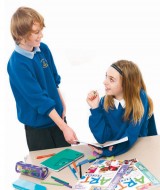Using the right framework, peer assessment can be powerful, productive and best of all painless, suggests Paul Dix...
Peer assessment that raises achievement cannot be left to chance. It must be structured, taught with reference to skills and strategies, accountable and supported with simple frameworks for conversation and feedback. Being able to hold the mirror up for others, while maintaining a good relationship, is a critical skill for teachers and pupils.
When executed well, peer assessment helps both parties to understand the next step in their learning. Lazy peer assessment, without structure or sharp focus is just another five minutes of conversation about the football, Club Penguin or the weekend. Peer assessment is not an afterthought or bolt on to impress the inspectors but an essential motor for a productive and efficient classroom
Before asking the children to launch into sensitive conversations about their learning, spend time demonstrating and deconstructing a model of what you want.
Try
• The teacher and TA modelling the etiquette of a peer conversation with the children listing the important elements (how we sit, take turns, listen, speak with private voices etc.).
• Asking children to deconstruct an audio recording of an assessment conversation between peers. Children should list ‘What works?’, ‘What doesn’t?’ and create their own routines.
• A live performance using two students. Ask the audience to reflect what is working and to step in and show how it might be improved.
• A video recording of children from last year/parallel classes to deconstruct.
• Performing a transcript of a peer assessment conversation for pupils to pick apart.
• Providing annotated examples of written work that has been peer marked.
It is vital that that you include strong examples of the high standard that you expect. Provide a weak model and the expectation is set too low. Ask your pupils to deconstruct the model, agree a list of success criteria and negotiate standards of conduct. Refer to this standard each time you ask the class to embark on a peer assessment task. Display agreements and guidelines as text, icons, photographs or on the screen. Reinforce the agreed expectation persistently. Do not allow them to become diluted or eroded over time.
Rituals and routines take some of the anxiety away from conversations about learning. Pupils like the predictable, safe and structured nature of the conversation that flows from a negotiated and agreed ritual. Keep the routine simple, clear, prominently displayed and referred to throughout the lesson.
 When children are asked to present their work to the class the feedback is usually given to the group as a whole. Just as with ‘desk’ work, some quickly learn work avoidance tactics and lean heavily on those who have a natural presence in front of an audience. Children who have contributed little to the presentation can remain hidden, avoiding the performance and the feedback. There are small changes to the routine that can ensure all students are involved, engaged and accountable for their contribution.
When children are asked to present their work to the class the feedback is usually given to the group as a whole. Just as with ‘desk’ work, some quickly learn work avoidance tactics and lean heavily on those who have a natural presence in front of an audience. Children who have contributed little to the presentation can remain hidden, avoiding the performance and the feedback. There are small changes to the routine that can ensure all students are involved, engaged and accountable for their contribution.
Before the first group presents their work, ask each member of the audience to identify one pupil who they will watch carefully throughout the presentation.
Usually what happens when a class performs in groups is that you respond enthusiastically to the first few, but by the time you have sat through the 8th version of the same thing you can barely muster a, ‘Well that was…interesting’. Establish the ritual and give each child in the audience a partner to feedback to. Ask the children to pair up and clarify the criteria that is to be assessed and the whole experience becomes much more about learning than crowd control. Meaningful individual feedback emerges and you will be relived to know that there is less emphasis on your hastily improvised summary judgement.
The audience will need to prepare in their heads, or write down, three aspects of the performance/presentation that met the agreed criteria and an area for improvement.
As each performance ends, ask the audience to prepare what they are going to say before having a conversation with their partner. Everyone works simultaneously so that no single voice can be heard in the room. Wander amongst the feedback and collect snippets of conversations that you can use to reinforce the agreed standard. Once children realise that they cannot avoid scrutiny, their motivation towards the task will shift. It is easy to hide in a group presentation when the assessment is about the group, not so easy when you know that you are being watched and will be assessed under specific criteria.
Do not rest until you have peer assessment that is rigorous, intelligent and respectful. Refuse to accept lazy conversations just as you refuse to accept incomplete work. Give real emphasis to modelling, negotiating and setting high expectations for peer assessment. After frequent exposure to the routine, the pressure for the teacher to assess everything will subside. Students will naturally begin to hold up the mirror for each other. By the end of term, the sea of hands or queue at your desk will have significantly reduced. Great. Take some time out. Sit back and watch your students teaching each other.
 Choose appropriate partners…
Choose appropriate partners…
Take control of the decisions on pairings as you take control of your seating plan. Make it clear that your expectation is that everyone will assess for and with each other and refuse to pander to the prejudices, friendships barriers and preconceptions. To begin with you may need to take the responsibility for choosing appropriate partners away from the children. Some will protest but most will feel more secure knowing that they can blame the groupings on you, ‘I know, I didn’t want to work with her either, he made me.’
Give marks with meaning…
Hand held Olympic style scorecards are fun, but as with any scoring mechanism the marks must have meaning. Agree a scale with the children before the group begins marking and relate this to the specific criteria that is being assessed.
More complex scoring systems might mirror those in gymnastics where technical difficulty, style and presentation can be assessed. Modern judging and scoring formats come from television shows such as Strictly Come Dancing.
Try this score card for a presentation:
| Totals | |
| Vocal control | 1 . 2 . 3 . 4 . 5 . 6 . 7 . 8 . 9 . 10 |
| Visual aids | 1 . 2 . 3 . 4 . 5 . 6 . 7 . 8 . 9 . 10 |
| Presentation style | 1 . 2 . 3 . 4 . 5 . 6 . 7 . 8 . 9 . 10 |
| Engaging the audience | 1 . 2 . 3 . 4 . 5 . 6 . 7 . 8 . 9 . 10 |
| Involving the audience | 1 . 2 . 3 . 4 . 5 . 6 . 7 . 8 . 9 . 10 |
| Technical difficulty | 1 . 2 . 3 . 4 . 5 . 6 . 7 . 8 . 9 . 10 |
| Passion for the topic | 1 . 2 . 3 . 4 . 5 . 6 . 7 . 8 . 9 . 10 |
| Evidence of research | 1 . 2 . 3 . 4 . 5 . 6 . 7 . 8 . 9 . 10 |
| Confidence with the material | 1 . 2 . 3 . 4 . 5 . 6 . 7 . 8 . 9 . 10 |
| Knowledge of the subject | 1 . 2 . 3 . 4 . 5 . 6 . 7 . 8 . 9 . 10 |
| Justification for the overall score… |
 Ask pupils to mark each other’s work…
Ask pupils to mark each other’s work…
1. Agree success criteria with the children using their own language in the first instance
2. Agree clear guidance for the markers: how to mark, acceptable/unacceptable comments
3. Let children mark work from past pupils. The markers can then compare their grading with actual grades and discuss variations.
4. Focus on one success criteria and break it down into the constituent parts for intensive assessment of a single criterion.
5. Display a number of pieces of work with children marking in teams. Each pupil will look for a certain aspect of the agreed criteria.
6. Play ‘speed marking’ with teams in competition to find where the marks have been earned/lost.
7. Try anonymous scripts to moderate the marking – research shows how the rank order of marking changes dramatically when teachers know which pupils submitted the work.
Paul Dix is an award winning teacher trainer renowned for his engaging and inspiring INSET. He is managing director of Pivotal Education and his new book The Essential Guide to Classroom Assessment (published in May 2010 Pearson/Longman) can be pre ordered with 10% discount for Teach Primary readers. Just email .(JavaScript must be enabled to view this email address) with code TP3 for your discounted copy.
Supporting parents with maths
Ace-Maths
Make every lesson an experiment
Cross Curricular
How to use Harry Potter to engage high-ability learners
Ace-Languages
